Mushrooms have long held a mysterious fascination for many people, especially with their unique and sometimes strange appearance. Black mushrooms in particular, tend to stand out from the rest and can be intriguing to discover.
Whether you are a novice forager looking to identify a black fungus you’ve come across or a seasoned enthusiast looking to update a list, you’ll enjoy the guide below.
What kind of mushrooms are black? In North America you can find black trumpet mushrooms, black morels, cloud ear, inky caps among others.
List of Wild Black Mushrooms
Be cautious when identifying and consuming wild mushrooms. If you are unsure whether a mushroom is safe to eat, it is best to err on the side of caution and not consume it.
1. Black Trumpet Mushrooms
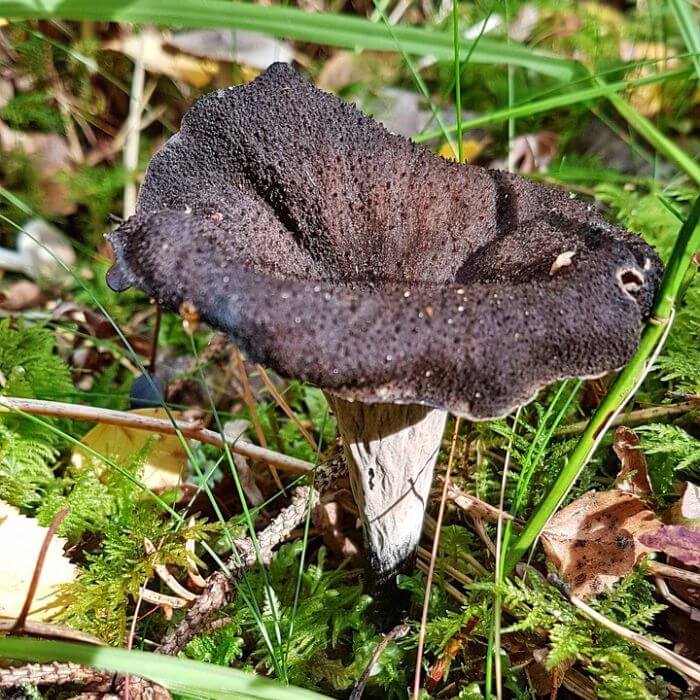
Black trumpet mushrooms are one of the most popular black mushrooms. From Georgia to Washington to Maine, these late summer mushrooms are perfect for anyone looking to add color and a rich earthy flavor to their meal.
Basic Facts
Depending on your state, this black fungus may be known as black chanterelle, horn of plenty or black trumpet.
The most obvious feature is their shape: their tall, thin stem grows up to 4 inches long with a wide, funnel-like black cap at its top. This cap can expand up to 3 inches across when fully mature and has wavy edges like other chanterelles.
Another way to identify it is through its texture. I’d describe it as suede-like. The underside does not have gills or has what foragers call ‘false gills’ . Next, do a spore test. Spore print is white or pinkish.
When can you find black trumpet mushrooms? They typically appear in the same area from late summer to fall. In some places like California they can last through winter.
They are usually found growing in small clusters on the ground. Check around mossy areas, near beech and oaks, and small streams. Check some awesome recipes at the end of this article.
2. Black Morel
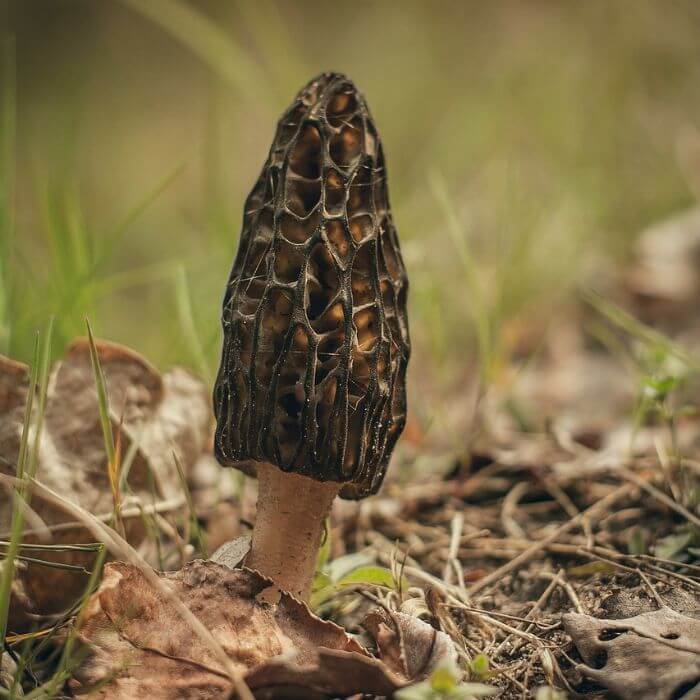
If you’ve been foraging for at least two years, you know March is one of the most exciting months in the foraging calendar.
Black morels often mark the beginning of the foraging season. After one heavy rain you’ll notice them pop up before other types of mushrooms. These mushrooms are common all over North America but infrequent in Florida.
Basic Facts:
The most distinctive feature of black morels is their cap. They range from light gray to black in color and have an irregularly shaped network of ridges and pits on the surface which resemble the structure of a honeycomb.
The stem is whitish and short, adding to its unique appearance. Like other morels, its inside should be hollow. These black mushrooms appear from mid-March in groups or singly on the ground.
3. Shiitake
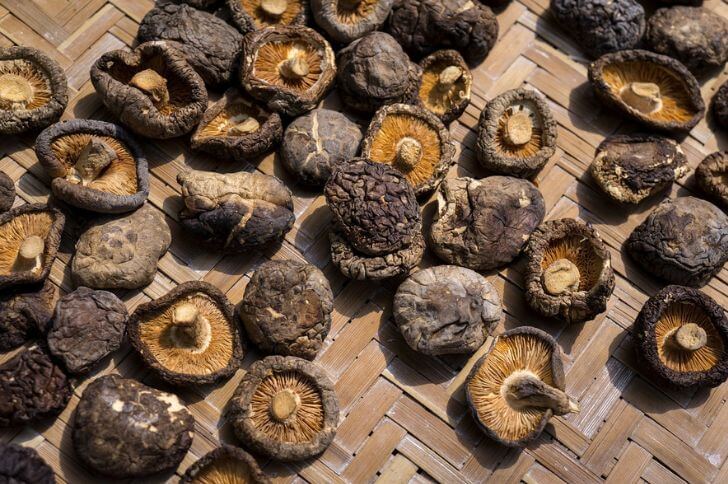
Most of us have heard about shiitake mushrooms. They are cultivated or grow in the wild in Asia, mostly China. And yes, you can find shiitake in North America in canned, dried or fresh forms.
Basic Facts:
Identifying shiitake mushrooms is actually quite simple once you know what to look for. They typically have brown to black caps that measure about three to six inches across and are curved inwards at the edges.
The gills underneath the cap will usually be creamy, although sometimes they can darken as the mushroom ages.
The stem of a shiitake mushroom should be fibrous and creamish. Additionally, it will have a distinct smell – earthy and slightly sweet – that sets it apart from other types of black mushrooms.
4. Black Velvet Bolete
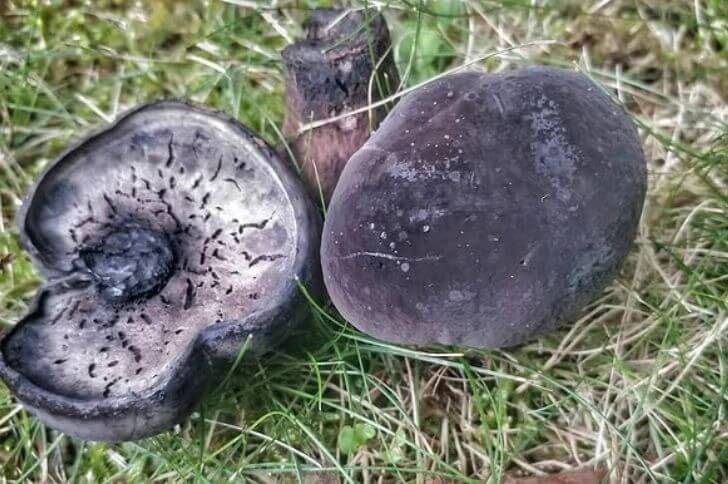
source:denden47
Extending from Maine to Texas, black Black velvet bolete mushrooms are a popular choice among mushroom foragers. I’d say it’s one of the best in the boletus family.
Basic Facts:
These mushrooms have a unique and distinct look, making them easy to identify even for those who may not have much experience with mushroom hunting. The black velvet bolete is easily identifiable by its black velvety cap and yellow pores on the underside of the cap.
The stem of this mushroom is also quite unique and stands out due to its smooth texture and a thick base.
The taste of these mushrooms can vary greatly depending on how they are cooked or prepared, but most people like frying them to bring out that nutty flavor.
5. Cloud Ear
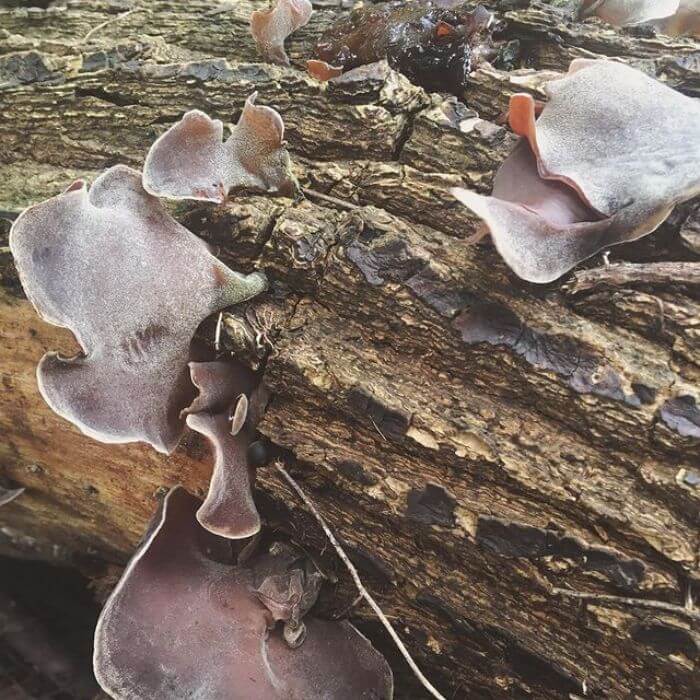
source: hillofthediamondpython
Mostly used in Asian cuisine, cloud ear mushrooms or wood ear are popular for their crunchy texture and umami flavor.
Basic Facts:
When fresh, they appear as small blackish-brown ears attached to a tree bark. Like the black velvet boletes above, they have smooth hairy surfaces.
When dried they resemble large ears or wrinkled sheets. Remember to reconstitute before you add to a soup.
6. Shaggy Mane
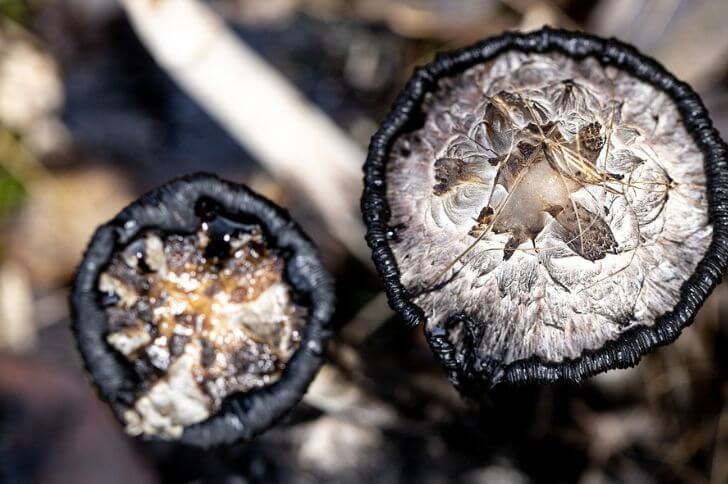
Shaggy mane mushrooms, also known as inky caps, are a distinctive type of fungus that can be found growing near decomposing wood and soil.
Basic Facts:
These mushrooms are identifiable by their conical shape and white scales on their cap. You might be confused, what is a white mushroom doing on this list?
As the inky cap ages, its canonical cap starts dying out. It changes color from white to black, producing an inky like substance. On its last days this mushroom’s fruiting body will be all-black.
Though the shaggy mane has been classified as choice edible, we recommend you keep it off the menu because it has coprine.
7. Black Elfin Saddle
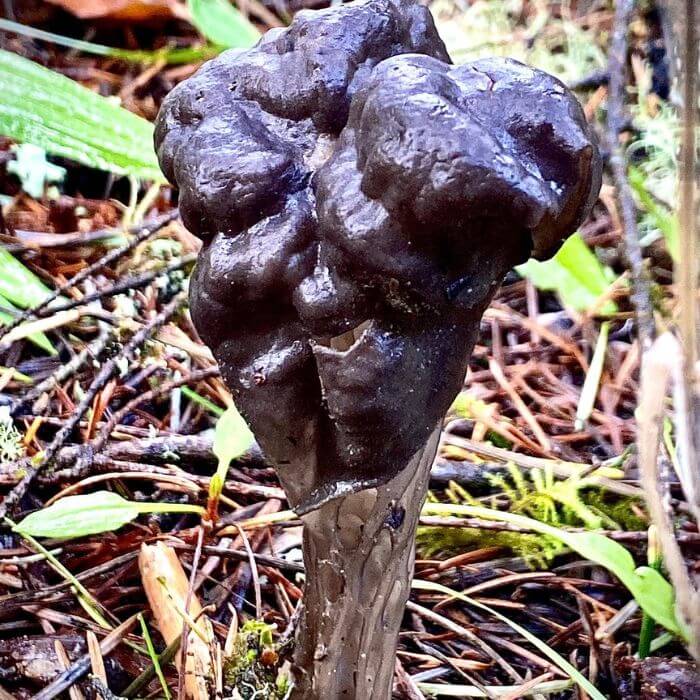
source: the_novice_one
If you live in Eastern North America, chances are you’ve come across this black fungus when mushroom hunting. It has a weird-looking shape and name; black elfin saddle. It is also common in Europe.
Basic Facts:
With its distinct appearance, identifying the black elfin saddle mushroom is relatively easy if you know what to look for.
The cap of this black mushroom typically measures 1 to 2 inches across and has a shape similar to that of a horse’s saddle or an upside down heart. Stems are hollow and wrinkly on the surface. Both the cap and stem feature a dark gray-black color. The flesh is thin but solid with an earthy aroma when cut open or handled.
8. Black Urn Mushroom
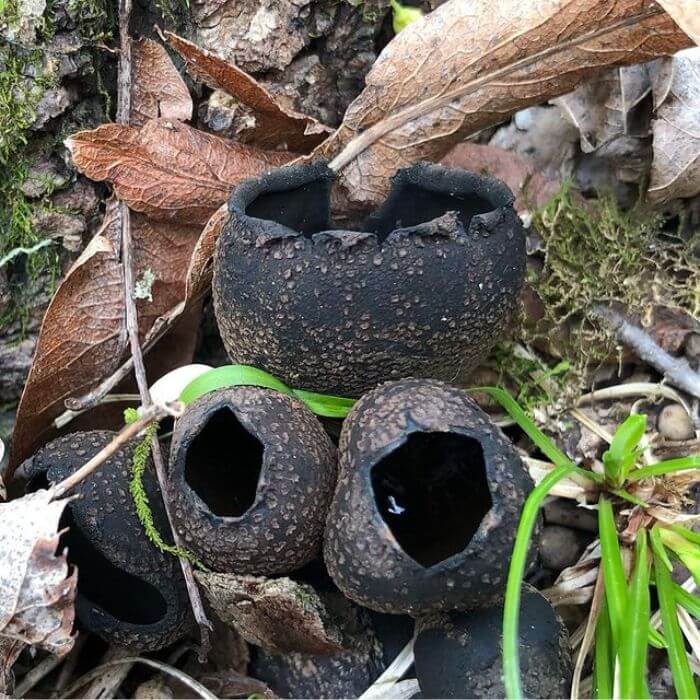
source: atheole
You might have read this list of orange colored fungi and came across the orange cup fungus, well the black urn mushroom is closely related to that tree mushroom.
Basic Facts:
Black Urn Mushroom, you may know it as the devil’s urn, is a March-May mushroom that favors the eastern states.
This species of mushroom is identified by its black cup-shaped cap. Note, cap remains closed in young species but opens with age. They have a brownish-black spore print and no gills. Black urns are inedible.
9. Black Tooth
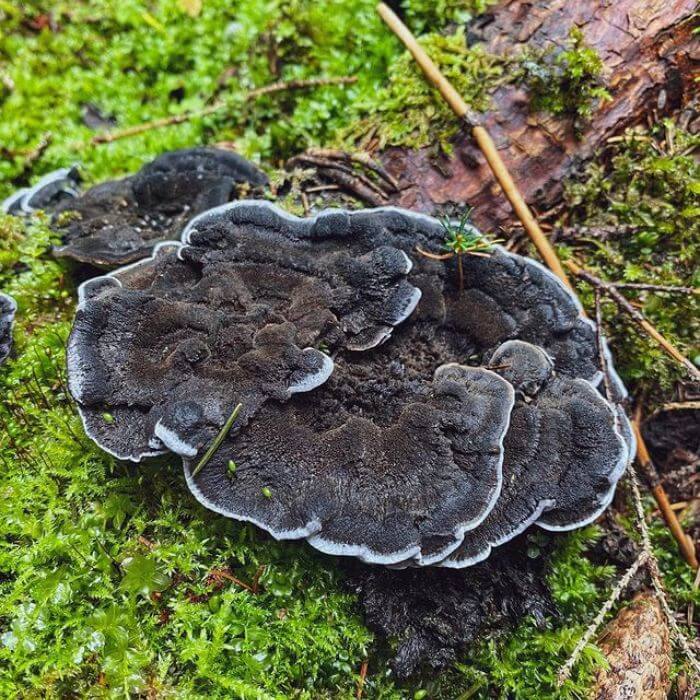
source: svampmarck
Phellodon niger is a unique black mushroom closely related to the beautiful devil’s tooth
Basic Facts:
Its black cap ranges from 2-4 inches in diameter with a shallow depression on its center. Furthermore, the underside reveals small spines, similar to what you’d see on hedgehog mushrooms. These unique black fungi are inedible.
10. Viscid Black Earth Tongue
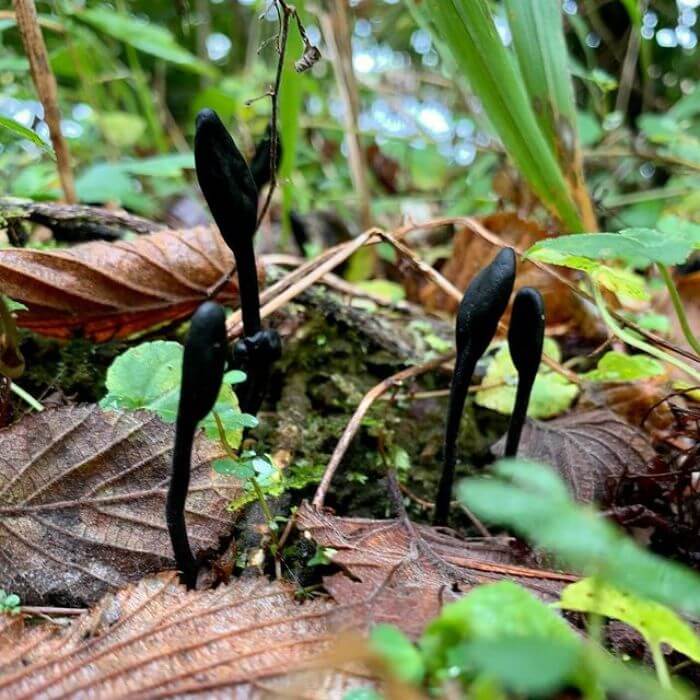
source: parkpaldublin
Found in dune slacks in Europe and in hardwood forest in North America, viscid black earth tongue or the glutinous earthtongue is a mushroom with a unique fruiting body.
Basic Facts:
Basically ,this small black mushroom looks like a tongue sticking out of the ground.
Also its unique black coloration makes it easily recognizable. While they can be found in many different areas throughout the world, they are most commonly encountered in woodlands and on grassy hillsides.
FAQs
Are wild black mushrooms edible?
Yes, some black fungi are edible. They include black chanterelle, black morels, black velvet boletes and shiitake. Be sure to identify correctly before cooking
Are black mushrooms rare?
No. Black trumpets mushrooms and black morels are common across North America. Others like shiitake are common across Southeast Asia.
What are black trumpets used for?
Black trumpets have an incredibly intense flavor due to their rich nutrients, which make them ideal for adding depth to dishes like soups, stews, pasta dishes, or risotto. Additionally, these mushrooms add great color contrast when added to mixed greens salads or stir-fries.
What mushroom has a black spore print?
Examples with black spore print include panaeolus olivaceus, inky caps, harefoot mushrooms, and earthballs.
Sources:
Hi There,
My name is Jenny. I’m the Chief Editor at Try Green Recipes and besides making yummy and healthy foods for my kids, grandkids, and friends. I’m new to the blogging world but I believe what I have to share is unique and will bring joy to your home. If you are adventurous and want try something tasty, let’s get started.

